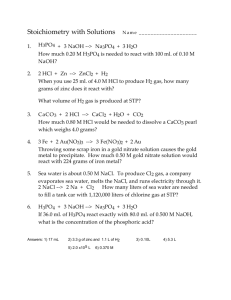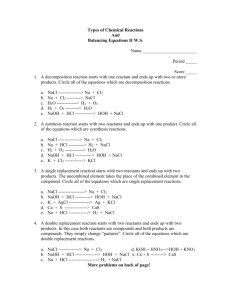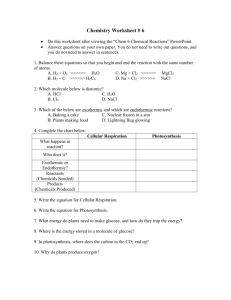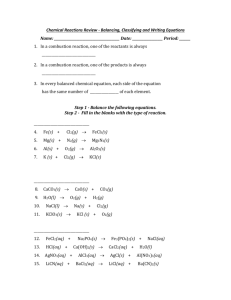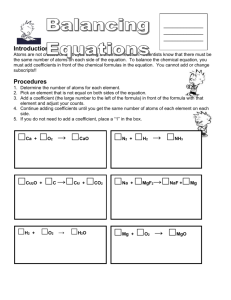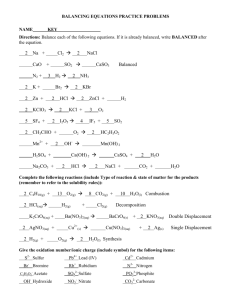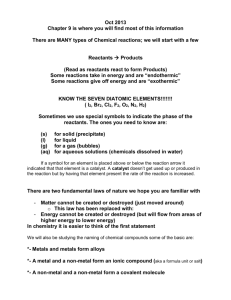Notes and answers to types of Reactions
advertisement
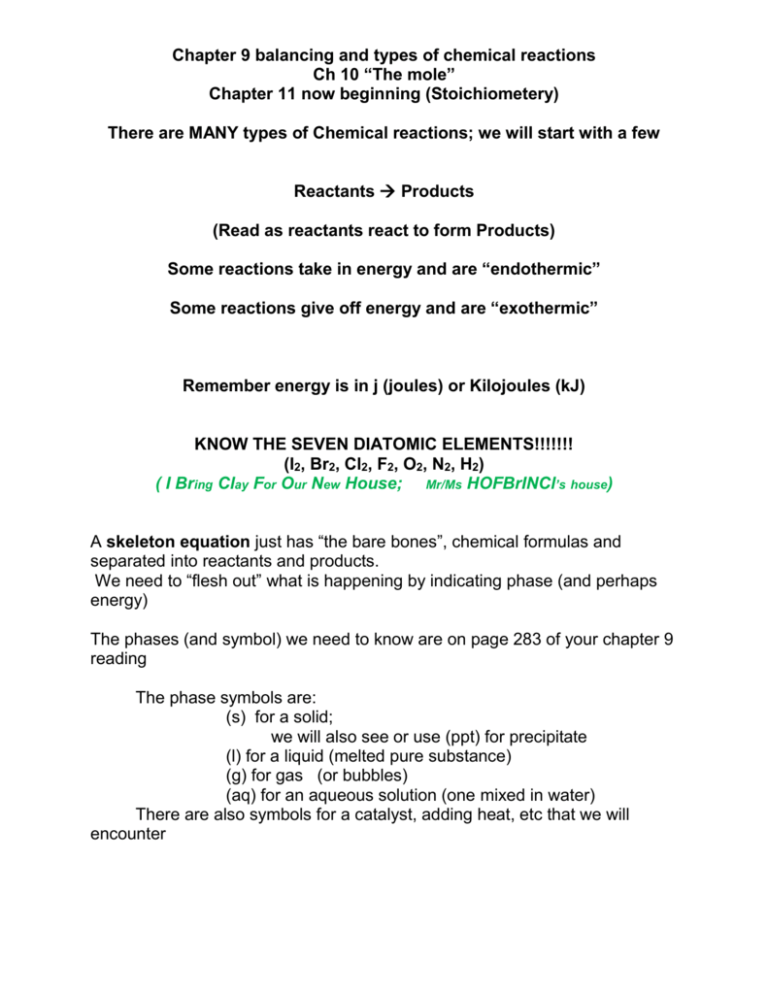
Chapter 9 balancing and types of chemical reactions Ch 10 “The mole” Chapter 11 now beginning (Stoichiometery) There are MANY types of Chemical reactions; we will start with a few Reactants Products (Read as reactants react to form Products) Some reactions take in energy and are “endothermic” Some reactions give off energy and are “exothermic” Remember energy is in j (joules) or Kilojoules (kJ) KNOW THE SEVEN DIATOMIC ELEMENTS!!!!!!! (I2, Br2, Cl2, F2, O2, N2, H2) ( I Bring Clay For Our New House; Mr/Ms HOFBrINCl’s house) A skeleton equation just has “the bare bones”, chemical formulas and separated into reactants and products. We need to “flesh out” what is happening by indicating phase (and perhaps energy) The phases (and symbol) we need to know are on page 283 of your chapter 9 reading The phase symbols are: (s) for a solid; we will also see or use (ppt) for precipitate (l) for a liquid (melted pure substance) (g) for gas (or bubbles) (aq) for an aqueous solution (one mixed in water) There are also symbols for a catalyst, adding heat, etc that we will encounter Types of Chemical Reactions Now that you know something about elements and compounds, lets see how they can react to for different stuff! Just like with Lego’s (the snap together building blocks) you can put them together, take them apart or swap them around. 1. A DECOMPOSITION reaction starts with one reactant and ends up with two or more products. Which of the following reactions are decomposition reactions? Circle the letters. a) b) c) d) e) 2. NaCl Na + Cl2 Na + Cl2 NaCl H2O H2 + O2 NaOH + HCl HOH + NaCl H2 + O2 H2O A SYNTHESIS reaction starts with two reactants and ends up with one product. Which of the following reactions are synthesis reactions? Circle the letters. a) b) c) d) e) 3. NaCl Na + Cl2 Na + Cl2 NaCl H2O H2 + O2 NaOH + HCl HOH + NaCl K +Cl2 KCl A SINGLE REPLACEMENT reaction starts with two reactants and ends up with two products. The uncombined element takes the place of the combined element in the compound. Which of the following reactions are single replacement reactions? Circle the letters. a) b) c) d) e) 4. NaCl Na + Cl2 NaOH + HCl HOH + NaCl K + AgCl2 Ag + KCl Na + HCl H2 + NaCl H2O H2 + O2 A DOUBLE REPLACEMENT reaction starts with two reactants and ends up with two products. In this case both reactants are compounds and both products are compounds. Which of the following reactions are double replacement reactions? Circle the letters a) b) c) d) e) NaOH + HCl HOH + NaCl Na + HCl H2 + NaCl K + AgCl2 Ag + KCl KOH + HNO3 KNO3 + HOH Ca + S CaS 5. A COMBUSTION reaction is when the reactants are oxygen and a hydro carbon and 6. the products are water and carbon dioxide. A NEUTRALIZATION reaction is a special type of double replacement reaction that will be covered in detail later on. By now something should be bothering you about many of the Chemical Equations listed above. Many of them ARE NOT BALANCED. Please follow the teacher examples of how to balance equations. Identifying and Balancing Chemical Equations Name: _________________________________ period: ____ Balance these equations (even if the value is one put it in the blank) and identify the type of reaction. (Synthesis, Decomposition, Single Replacement, Double Replacement or Combustion) Type of reaction 1. __HgO __Hg + __O2 2. __ NaCl + __ AgNO3 3. __ Cl2 + __ Ca ____________ __NaNO3 + __AgCl __ CaCl2 ____________ ____________ 4. __ C2H6 + __ O2 __CO2 + __H2O ____________ 5. __ H2O + __ Fe __ Fe2O3 + __ H2 ____________ 6. __ Al2S3 + __Ca(OH)2 __ Al(OH)3 + __ CaS ____________ 7. __ S8 + __ Fe __ FeS ____________ 8. __ N2 + __ H2 __ NH3 ____________ __ KCl + __ O2 ____________ 9. __ KClO3 10. __ Al2(SO4)3 + __Ca(OH)2 __ Al(OH)3 + __ CaSO4 ____________ Glencoe Chapter 9 book problems (start on p288): 7-12 (Prentice Hall) Chapter 11 book problems: 1, 2, 3, 4, 11, 12, 14, 15, 18, 24, 28, 41, 49, 51, 54 Types of Chemical Reactions with answers Now that you know something about elements and compounds, lets see how they can react to for different stuff! Just like with Lego’s (the snap together building blocks) you can put them together, take them apart or swap them around. 1. A DECOMPOSITION reaction starts with one reactant and ends up with two or more products. Which of the following reactions are decomposition reactions? Circle the letters. a) b) c) d) e) 2. NaCl Na + Cl2 Na + Cl2 NaCl H2O H2 + O2 NaOH + HCl HOH + NaCl H2 + O2 H2O A SYNTHESIS reaction starts with two reactants and ends up with one product. Which of the following reactions are synthesis reactions? Circle the letters. a) b) c) d) e) 3. NaCl Na + Cl2 Na + Cl2 NaCl H2O H2 + O2 NaOH + HCl HOH + NaCl K +Cl2 KCl A SINGLE REPLACEMENT reaction starts with two reactants and ends up with two products. The uncombined element takes the place of the combined element in the compound. Which of the following reactions are single replacement reactions? Circle the letters. a) b) c) d) e) 4. NaCl Na + Cl2 NaOH + HCl HOH + NaCl K + AgCl2 Ag + KCl Na + HCl H2 + NaCl H2O H2 + O2 A DOUBLE REPLACEMENT reaction starts with two reactants and ends up with two products. In this case both reactants are compounds and both products are compounds. Which of the following reactions are double replacement reactions? Circle the letters. a) b) c) d) e) NaOH + HCl HOH + NaCl Na + HCl H2 + NaCl K + AgCl2 Ag + KCl KOH + HNO3 KNO3 + HOH Ca + S CaS 5. A COMBUSTION reaction is when the reactants are oxygen and a hydro carbon and 6. the products are water and carbon dioxide. A NEUTRALIZATION reaction is a special type of double replacement reaction that will be covered in detail later on. By now something should be bothering you about many of the Chemical Equations listed above. Many of them ARE NOT BALANCED. Please follow the teacher examples of how to balance equations. Identifying and Balancing Chemical Equations Name: _______ANSWERS_________ period: ____ Balance these equations (even if the value is one put it in the blank) and identify the type of reaction. (Synthesis, Decomposition, Single Replacement, Double Replacement or Combustion) Type of reaction 1. _2_HgO + _2_Hg + _1_O2 2. _1_ NaCl + _1_ AgNO3 3. _1_ Cl2 + _1_ Ca __Decomposition_ _1_NaNO3 + _1_AgCl _1_ CaCl2 4. _2_ C2H6 + _7_ O2 _4_CO2 + _6_H2O 5. _3_ H2O + _2_ Fe _1_ Fe2O3 + _3_ H2 6. 1 Al2(SO4)3 + 3 Ca(OH)2 _Double Replace_ ___Synthesis___ __combustion___ _single replacement_ 2 Al(OH)3 + 3 CaSO4 _Double Replace_ 7. _1_ S8 + _8_ Fe _8_ FeS ___ Synthesis __ 8. _1_ N2 + _3_ H2 _2_ NH3 __ Synthesis __ 9. _2_ KClO3 _2_ KCl + _3_ O2 10. 1 Al2(SO4)3 + 3 Ca(OH)2 __Decomposition_ 2 Al(OH)3 + 3 CaSO4 __Double Replace_ Review warm-up for the limiting reagents part of Stoichiometery Review: What type of reactions are these? 1) NaOH + KNO3 --> NaNO3 + KOH 2) CH4 + 2 O2 --> CO2 + 2 H2O 3) 2 Fe + 6 NaBr --> 2 FeBr3 + 6 Na 4) CaSO4 + Mg(OH)2 --> Ca(OH)2 + MgSO4 5) NH4OH + HBr --> H2O + NH4Br 6) Pb + O2 --> PbO2 7) Na2CO3 --> Na2O + CO2 - Skeletal equation (bare bones) - Balanced equation (minimum necessary to do stoichiometry calculations) - Balanced equation with phase information o (solid (s), liquid (l), Gas(g), aqueous solution (aq)) - (Equations where everything is written as ions, elements or molecules help you understand how to balance the compounds and then the equation) - Net ionic equations: then you strip away any ion that stay in solution from the Chapter 11 book problems: 1, 2, 3, 4, 11, 12, 14, 15, 18, 24, 28, 41, 49, 51, 54 Book problem answers: 1) Solid sodium metal and liquid water react to form a solution of sodium hydroxide and bubbles of hydrogen gas. 2) S(s) + O2(g) SO2 (g) but you might not know this 3) a) 2 AgNO3 + H2S Ag2S + 2 HNO3 b) 3 Zn(OH)2 + 2 H3PO4 Zn3(PO4)2 + 6 H2O 4) a) b) H2 + S H2S FeCl3 + Ca(OH)2 Fe(OH)3 + CaCl2 11) a) b) Fe(s) + Cl2(g) FeCl3(s) Al2(CO3)3(s) Al2O3(s) + CO2(g) 12) a) 2 SO2 + O2 2 SO3 b) Fe2O3 + 3 H2 2 Fe + 3 H2O c) 4 P + 5 O2 P4O10 d) 2 Al + N2 2 AlN 14) 3 Mg(s) + N2(g) Mg3N2 15) Complete and balance this decomposition reaction: 2 HI H2 + I2 ; remember diatomic elements (I Br Cl F O N H) 18) Write the products of these double-replacement reactions. Then Balance each equation. a) 3 NaOH(aq) + Fe(NO3)3(aq) Fe(OH)3(s) + 3 NaNO3 b) 3 Ba(NO3)2(aq) + 2 H3PO4(aq) Ba3(PO4)2(s) + 6 HNO3(aq) 24) 28) Classify and balance each: a) 2 C3H6 + 9 O2 6 CO2 + 6 H20 b) 2 Al(OH)3 Al2O3 + 3 H2O c) Li + O2 Li2O d) Zn + 2 AgNO3 2 Ag + Zn(NO3)2 Write the balanced net ionic equation for this reaction. (as written) Ca2+(aq) + OH-(aq) + H+(aq) + PO4-3(aq) Ca2+ + PO43-(aq) + H2O(l) You just don’t write the stuff that is on both sides: so… Ca2+(aq) + OH-(aq) + H+(aq) + PO4-3(aq) Ca2+ + PO43-(aq) + H2O(l) Or simplified it is: 41) 49) reactions combustion decomposition synthesis single replacement OH-(aq) + H+(aq) H2O(l) Balance each : a) a bb team: C + 2 F + 2 G CF2G2 b) a tricycle: F + 3 W + S + 2 P FW3SP2 Write a balanced equation for each of the following double replacement a) H2C2O4(aq) + KOH(aq) K2C2O4 + 2 HOH b) CdBr2(aq) + Na2S(aq) CdS(s) + 2 NaBr(aq) 51) Write a balanced equation for the complete combustion of each compound a) C4H8 + 6 O2 4 CO2 +4 H2O b) C3H6O + 4 O2 3 CO2 + 3 H2O ; (the reactant also has oxygen) 54) Write a net ionic equation for each of the following reactions. a) 2 HCl(aq) + Ca(OH)2(aq) CaCl2 + 2 HOH as ions it is written as: 2 H+ + 2Cl- + Ca2+ + 2(OH)- Ca2+ + 2Cl- + 2H2O ; water’s a molecule not an ionic compound Cross out the ions that are on both sides gives us: + 2 H + 2Cl- + Ca2+ + 2(OH)- Ca2+ + 2Cl- + 2H2O Or 2 H+ + 2(OH)- 2H2O ( the net ionic equation) b) AgNO3(aq) + AlCl3(aq) silver chloride is a precipitate so… 3 AgNO3(aq) + AlCl3(aq) 3 AgCl(s) + 1 Al(NO3)3(aq) as ions it is: 3 Ag+ + 3 (NO3)-(aq) + Al3+ + 3Cl-(aq) 3 AgCl(s) + 1 Al3+ + 3(NO3)-(aq) Cross out the same ones to get net ionic: 3 Ag+ + 3 (NO3)-(aq) + Al3+ + 3Cl-(aq) 3 AgCl(s) + 1 Al3+ + 3(NO3)-(aq) Or simply: 3 Ag+ + 3Cl-(aq) 3 AgCl(s) (the net ionic equation) The activity series of metals Chemical Equations Name: _________________________________ Look at the activity series for metals on page 333 of you text; (or at the following table) Note: decreasing activity top to bottom Metals from Li to Na will replace H from acids and water; From Mg to Pb they will replace H from acids only Predict if any reaction will take place. Balance the equations or any reaction that will occur 11. Mg(s) + FeSO4 (aq) 12. Mg(s) + NaCl (aq) 13. Fe(s) + Pb(NO3)2 (aq) 14. Cu(s) + Al2(SO4)3 (aq) 15. Ag(s) + ZnS (aq) 16. Zn(s) + H2O (l) 17. Ag(s) + H2SO4 (aq) 18. Fe(s) + HCl (aq) 19. Na(s) + H2O (l) 20. Pb(s) + H2O (l) 21. Li(s) + Mgl2 (aq) 22. Al(s) + HCl (aq) period: ____ Name Lithium Potassium Calcium Sodium Magnesium Aluminum Zinc Iron Lead (hydrogen) Copper Mercury Silver Symbol Li K Ca Na Mg Al Zn Fe Pb H Cu Hg Ag The seven diatomic elements H2, N2, O2, F2, Cl2, Br2, I2 When in their natural state (gases since most have very low boiling points) these elements “pair up” into molecules (non-metal to non-metal). They seem to do this to have a complete valence shell. You must have these memorized in order to properly write balanced chemical equations. Here are some tricks I have learned. An oldie but a goodie I Bring Clay For Our New House ( 4 paving 8 sidewalks; P4 S8 ) One teacher said all the elements got together to honor to honor a great chemistry Ms. (or Mr.) HOFBrINCl (spell it just like it sounds) One particularly energetic cheerleader noticed that it was and a hockey stick (3 across and 4 down N, O, F, Cl, Br, I). H (hockey puck) However you wish to memorize them JUST DO IT !!!

